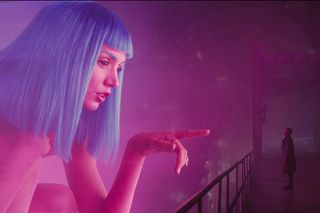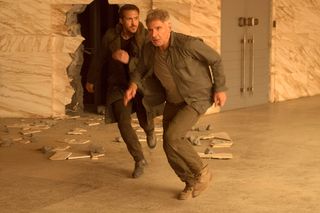Review: 'Blade Runner 2049' Comes Oh-So-Close to Original's Eerie Awesomeness
Warning: This review contains spoilers for "Blade Runner 2049."
When I saw the word "Atari" eerily glowing on a building in the devastated Los Angeles of "Blade Runner 2049," I knew everything was going to be just fine.
The long-awaited sequel to 1982's "Blade Runner" delivers another punch to the gut while addressing robot rights. The first film asked if replicants — the slave robots that work in off-world colonies — have the right to live a life of their choosing. The new film asks if they have the right to give birth.
It's an interesting premise on its own, but what makes "2049" shine is its dedication to the eerie atmosphere of the original, including mentions of the brand names of companies that appeared in 1982. Atari and Pan-Am (two names I spotted) were among several real-life '80s-era companies that had product placements in the original film. It's a long-running joke among "Blade Runner" fans. [Strange Cinema: Space.com's Favorite Off-Beat Space Movies]
It's not just the names that are consistent. The eerie soundtrack by Hans Zimmer sounds just like a new Vangelis album. Parts of the original "Blade Runner" are shown again in glorious high definition (and, in the version I saw, crisp 3D.) The only real weakness of the film was the pacing. Slow is appropriate for detective stories, but "2049" took detours that almost derailed the plot a few times.
Before the review continues, a quick warning for parents: While Space.com (and this review) targets a general audience, "Blade Runner 2049" is rated R and has scenes not appropriate for young children.

Detective replicant
"2049" follows the trail of K (played by Ryan Gosling). "K" is an abbreviation of his serial number, as he is a replicant. K is a "blade runner," a unit that hunts and kills renegade replicants.
Get the Space.com Newsletter
Breaking space news, the latest updates on rocket launches, skywatching events and more!
The original film took place in 2019, just weeks after the Nexus 6 version of replicants killed 23 people in an off-world revolt. In "2049," we learn K is part of a newer, more "obedient" generation of replicants. But some of the older revolutionaries are still alive, in hiding. K tracks down one of these replicants — Sapper Morton (Dave Bautista, known for "Guardians of the Galaxy") — at a derelict protein farm. After killing Morton, K finds a mysterious box that yields astonishing evidence of a Nexus 6 replicant that gave birth to a child.
When Lt. Joshi (played by Robin Wright) hears this news, she orders K to destroy all evidence of that birth. That includes eliminating the child, who is presumably alive and in hiding somewhere. K's first move is to go to the replicant manufacturing facility, where he learns this child has some connection to former Blade Runner Rick Deckard (Harrison Ford, who reprises his classic character).
The film's detective story unfolds at a leisurely pace, allowing viewers to take in some of the awesome technologies of 2049. These include flying cars equipped with drones, a surprisingly real-looking holographic girlfriend named Joi (Ana de Armas), and home entertainment systems equipped with simulated versions of real-life performers. Sadly, you won't hear much about the off-world colonies in this film, but perhaps another sequel will take this on.
2049's technology, however, came at a price. In San Diego, we see squatters amid building-size garbage piles. Radiation still blankets Las Vegas, which terrorists attacked years ago. We also can't forget the price paid by the replicants: Even decades after the rebellion, Joshi still speaks in racist tones about the divide between humans and machines, and tells K that he's getting along just fine without a soul. [Ford and Gosling Team Up in New 'Blade Runner 2049': Images]

Feeling the ambiance
Director Denis Villeneuve, who is best known among space fans for 2016's "Arrival," meticulously takes us, scene by scene, person by person, through K's quest to find Deckard and the replicant child. Small details really matter in this film, so he is careful to repeat key lines and scenes in flashbacks to make sure we're keeping up. (The 1982 film's director, Ridley Scott, served as executive producer.)
It's fascinating to watch the complex plot slowly unwind its threads, with constant small nods to the original that will please fans. You'll see some familiar faces, and also learn new details about replicants' implanted memories.
"2049" also has compelling new characters. Niander Wallace (Jared Leto) runs a replicant manufacturing facility and is creepily cavalier with the lives he creates. His replicant Luv (Sylvia Hoeks) beautifully shows how the new line of replicants don't simply obey masters, but are instead complex beings.
But, my goodness, the pacing. The theatrical cut of the 1982 film was just shy of a crisp 2 hours, while the 2017 sequel runs close to 3. Some scenes and characters didn't merit that much time. For example, while de Armas put in a great performance as Joi, who experiences child-like wonder about weather and cityscapes, she had a ridiculous amount of screen time. Her character's main purpose appears to be to show love and support for K, which is touching but got to be a little much during a drawn-out sex scene showing her holographic capabilities.
Similar detours threatened to derail "2049" at least twice, but veterans Villeneuve and Scott kept their footing. Late in the film — where many of this summer's sequels got tedious — "2049" still delivers surprises, and a few intriguing hints of replicant activities that we'd love to see explored in future films.
Go watch this on the big screen. "2049" more than delivers on its promise as an awesome sequel. Both Villeneuve and Gosling told the Los Angeles Times that they're not closing the door on revisiting this messy world — and if they do, let's hope we finally get to see those off-world colonies everyone talks about.
Follow us @Spacedotcom, Facebook and Google+. Original article on Space.com.
Join our Space Forums to keep talking space on the latest missions, night sky and more! And if you have a news tip, correction or comment, let us know at: community@space.com.

Elizabeth Howell (she/her), Ph.D., is a staff writer in the spaceflight channel since 2022 covering diversity, education and gaming as well. She was contributing writer for Space.com for 10 years before joining full-time. Elizabeth's reporting includes multiple exclusives with the White House and Office of the Vice-President of the United States, an exclusive conversation with aspiring space tourist (and NSYNC bassist) Lance Bass, speaking several times with the International Space Station, witnessing five human spaceflight launches on two continents, flying parabolic, working inside a spacesuit, and participating in a simulated Mars mission. Her latest book, "Why Am I Taller?", is co-written with astronaut Dave Williams. Elizabeth holds a Ph.D. and M.Sc. in Space Studies from the University of North Dakota, a Bachelor of Journalism from Canada's Carleton University and a Bachelor of History from Canada's Athabasca University. Elizabeth is also a post-secondary instructor in communications and science at several institutions since 2015; her experience includes developing and teaching an astronomy course at Canada's Algonquin College (with Indigenous content as well) to more than 1,000 students since 2020. Elizabeth first got interested in space after watching the movie Apollo 13 in 1996, and still wants to be an astronaut someday. Mastodon: https://qoto.org/@howellspace
